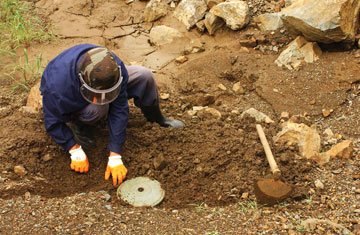|
NEWS NOTES
Landmine detectors thwarted by soils
 NATO |
| A worker prepares to destroy landmines. |
Searching for landmines is not only extremely dangerous work, it’s also difficult. Those tasked with removing landmines typically use metal detectors to locate them, but they don’t always work. And there’s no way of knowing when they will work and when they won’t. But things are improving, thanks to geoscientists who have developed the first soil classification system that can help officials determine where metal detectors are likely to encounter problems.
Soils rich in iron minerals can play tricks on metal detectors, which rely on electromagnetic induction to locate landmines. It’s difficult for metal detectors to accurately differentiate between naturally occurring magnetic minerals and landmines, especially newer landmines that are largely made of plastic and contain very little metal. But this hasn’t always been appreciated. “Ten years ago, no one was talking about the effects of soil properties on sensors,” says Jan Hendrickx, a soil hydrologist at New Mexico Tech in Socorro, who was not involved in the new research. But it’s a serious issue.
Holger Preetz, a geoscientist at the Leibniz Institute for Applied Geosciences in Hanover, Germany, realized the magnitude of the problem a couple years ago, after speaking with a group in charge of finding and removing landmines in Mozambique that was having problems with their metal detectors. Preetz and his colleagues set out to find a systematic method that would help such groups decide when to use a metal detector and when it might be better to call in the landmine-sniffing dogs or rats.
The researchers focused their efforts on tropical soils, because many of the 90 countries affected by landmines are in the tropics. In particular, the team studied the most common type of tropical soil: laterite. Laterites — sometimes called Oxisols or Ferrasols — are soils that contain large amounts of iron and aluminum.
The presence of iron oxide minerals, such as magnetite or maghemite, is what makes soil susceptible to magnetism and thus interferes with metal detectors’ readings. The amount of magnetite or maghemite in soils depends on both parent rock material and the degree of weathering. Preetz and his colleagues considered these factors when they tested the magnetic susceptibility of 511 laterite samples.
More than a third of the samples severely affected a metal detector’s ability to function. A soil’s parent rock had a big influence on whether it affected metal detectors. Soils made from ultrabasic or basic igneous rock, such as basalt, were the worst offenders, probably due to the iron-rich magma that gives rise to these rocks, the researchers wrote in the January-February issue of Soil Society of America Journal. Within each parent rock type, however, the researchers found a lot of variation in magnetic susceptibility that’s likely due to weathering: The more weathering, the more magnetic susceptibility of the soil.
Based on these results, Preetz and his colleagues developed a simple soil classification system that anyone can use. “If you start demining operations in an unknown area — without information on the landscape or without [prior] experience there — you can look on a soil map and look at our classification system and get a first approximation of the problems there,” Preetz says. It’s “a nice example of how geosciences can contribute to eliminate landmines,” Hendrickx adds.
Preetz and his colleagues now plan to further refine their classification system by considering additional factors that may affect landmine detection, such as how different frequencies used by metal detectors affects a soil’s magnetic susceptibility. They will also test out their system by applying it to a soil map of Angola to create a guide that shows where metal detectors are unlikely to work, Preetz says.

 Subscribe
Subscribe


